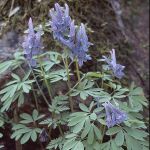| Common Name: |
Bulbous Corydalis |
| Other Names: |
Fumewort |
| Botanical Name: |
Corydalis solida syn. C. halleri, C. transsylvanica hort. |
| Genus: |
Corydalis |
| Family: |
Papaveraceae |
| Native Location: |
N Europe to W Asia |
| Cultivation: |
Well-drained, rich, moist soil in partial shade. Position of plants should be clearly marked because they die down completely in summer. All parts of Corydalis are very brittle and must be handled carefully. The tender foliage is prone to attack by slugs and snails. |
| Propagation: |
By seed sown when ripe; by division of tubers in autumn. |
| Harvest: |
Tubers are collected during dormancy and dried for use in decoctions. |
| Height: |
10-25cm (4-10in) |
| Width: |
10-20cm (4-8in) |
| Hardiness: |
Z5-8 |
| Parts Used: |
Tubers (yan hu suo) |
| Properties: |
A painkilling herb that stimulates the circulation, controls spasms and nausea, and has sedative and anti-bacterial properties. Research also suggests action on the thyroid and adrenal cortex. |
| Medicinal Uses: |
Internally for painful menstruation, abdominal pain (especially in appendicitis and peptic ulcer), traumatic injury, insomnia, and tremors in neurological disease. Not given to pregnant women. |
| Bibliography: |
Encylopedia of Herbs by Deni Brown Copyright ©: 1995, 2001 Dorling Kindersley Limited pg 181
|

